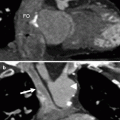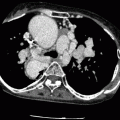, Marilyn J. Siegel2, Tomasz Miszalski-Jamka3, 4 and Robert Pelberg1
(1)
The Christ Hospital Heart and Vascular Center of Greater Cincinnati, The Lindner Center for Research and Education, Cincinnati, OH, USA
(2)
Mallinckrodt Institute of Radiology, Washington University School of Medicine, St. Louis, Missouri, USA
(3)
Department of Clinical Radiology and Imaging Diagnostics, 4th Military Hospital, Wrocław, Poland
(4)
Center for Diagnosis Prevention and Telemedicine, John Paul II Hospital, Kraków, Poland
Abstract
In the Ross procedure, the normal pulmonary valve with part of the pulmonary artery is moved to the aortic position to replace a diseased aortic valve and the native pulmonary artery and valve are replaced with a pulmonary homograft. The coronary arteries are transplanted into the neoaorta (native pulmonary artery). This procedure is the operation of choice in infants and children, since it allows the valve replacement to grow as the patient matures thus eliminating the need for anticoagulation to prevent thromboembolism. Its use in adults remains controversial.
Stay updated, free articles. Join our Telegram channel

Full access? Get Clinical Tree








